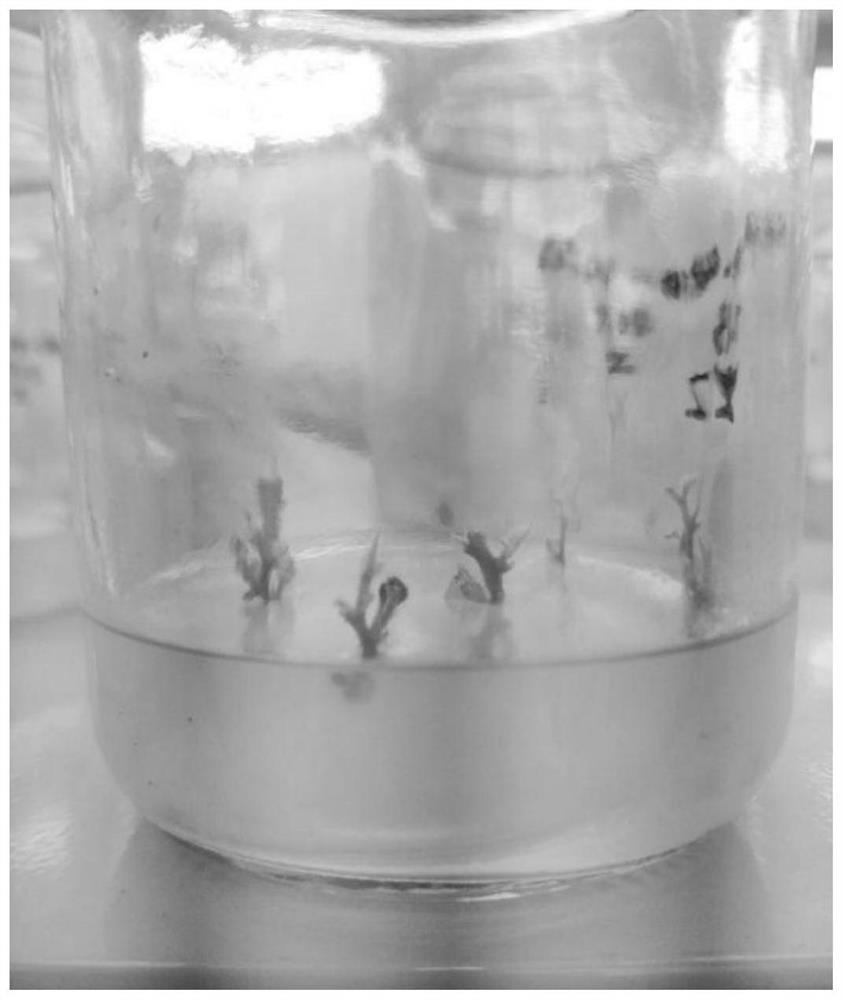Tissue culture and rapid propagation method of actinidia deliciosa root stocks
A technology for tissue culture and rapid propagation of kiwifruit, which is applied in the field of tissue culture and rapid propagation of kiwifruit and delicious kiwifruit rootstocks, and can solve the problem that the technology of tissue culture and rapid propagation of 'Jinkui' kiwifruit has not been reported in the literature, and the cultivation method is difficult to fully apply , high gene heterozygosity, etc., to save rooting time, shorten the time, and increase the growth rate
- Summary
- Abstract
- Description
- Claims
- Application Information
AI Technical Summary
Problems solved by technology
Method used
Image
Examples
Embodiment 1
[0034] Embodiment 1 explant processing
[0035] Rinse the branches collected in the field for 30 minutes under running water, place them on the ultra-clean workbench, sterilize them with 75% alcohol for 3 minutes, rinse them with sterile water for 4 times, and use 0.1% HgCl 2 The solution was sterilized, the time was set to 4, 6, 8, 10, 12min, and the sterile water was washed 4 times. Sterilized stem segments were cut into 1.5cm lengths, each stem segment had an axillary bud, and inserted vertically into the medium, which was MS medium supplemented with 0.2mg / L NAA and 2mg / L 6-BA. After 30 days, the pollution rate was counted. At the same time, explore the alcohol disinfection test after raising mercury first, and the time setting remains unchanged. The test results are shown in Table 1.
[0036] Rinse the branches collected in the field under running water for 30 minutes, add 0.1ml / L bristol clear to soak for 10 minutes (with no bristol clear as the control), rinse 3 times...
Embodiment 2
[0044] Embodiment 2 adventitious bud regeneration induction
[0045] The terminal buds or axillary buds of the above-mentioned sterilized twigs were cut in the ultra-clean workbench as explants. When cutting the terminal buds, try to cut off all the small leaves and fluff around them, and keep about 0.3-0.5cm and insert them vertically into the bud induction medium; At about 1cm, insert the bud induction medium so that the axillary buds face upward. The bud induction medium is MS medium supplemented with 0.2mg / L NAA and 1-5mg / L 6-BA. One stem segment in each culture bottle, 10 bottles for each treatment, repeated 3 times. Place them under the conditions of light intensity 3000-3200Lux, light duration 12h / d, and temperature 24°C for cultivation. After 30 days, the survival rate was counted, and whether there was browning, vitrification, etc. was investigated. The test results are shown in Table 3.
[0046] Table 3 The effect of different mass volume ratios of 6-BA on the i...
Embodiment 3
[0051] Embodiment 3 Adventitious bud proliferation culture
[0052] With MS as basic medium, 6-BA and GA3 were added for treatment. The concentration gradient of 6-BA was set to 0.3mg / L, 0.5mg / L, and 0.7mg / L. The treatment of GA3 was divided into two types: adding before sterilization and adding after sterilization. The concentration gradient before sterilization was set at 1mg / L. L, 2mg / L, 3mg / L, 4mg / L, 5mg / L, the concentration gradient after sterilization is set to 0.1mg / L, 0.2mg / L, 0.3mg / L, 0.4mg / L (after filtering through the filter, add ). 3-4 stem segments per bottle, 10 bottles per treatment, repeated 3 times. Placed under the conditions of light intensity 3000-3200Lux, light 12h / d, and temperature 24°C, the proliferation of adventitious buds was cultured for 30 days, and the proliferation coefficient was counted to investigate whether there were browning and vitrification. The test results are shown in Table 4.
[0053] Table 4 Effects of different mass-volume rati...
PUM
 Login to View More
Login to View More Abstract
Description
Claims
Application Information
 Login to View More
Login to View More - R&D Engineer
- R&D Manager
- IP Professional
- Industry Leading Data Capabilities
- Powerful AI technology
- Patent DNA Extraction
Browse by: Latest US Patents, China's latest patents, Technical Efficacy Thesaurus, Application Domain, Technology Topic, Popular Technical Reports.
© 2024 PatSnap. All rights reserved.Legal|Privacy policy|Modern Slavery Act Transparency Statement|Sitemap|About US| Contact US: help@patsnap.com










